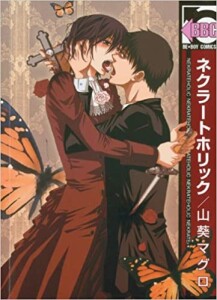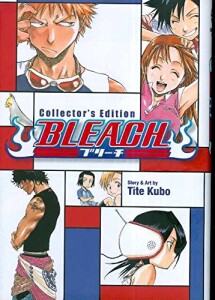Matsuri Hino’s Vampire Knight (Vols. 1-5)
Maguro Wasabi’s Necratoholic
Tite Kubo’s Bleach, Vols. 1-2
 Comics and graphic novels have always had an affinity for the bizarre, surreal, fantastic, and otherwise otherworldly, and manga is no exception. Although many titles – probably most – deal with the here and now, many series take place in future universes, alternate historical universes, and sometimes even fairly standard fantasy universes. There are a number of series and single-volume manga that fall into the broad category of “speculative fiction,” so I thought I’d take a look at a few that have caught my attention. Since my intended one-piece “omni” review rapidly grew to mammoth proportions, I’ve divided it into sections. The first group I want to discuss deals with vampires, ghosts, and things that go bump in the night.
Comics and graphic novels have always had an affinity for the bizarre, surreal, fantastic, and otherwise otherworldly, and manga is no exception. Although many titles – probably most – deal with the here and now, many series take place in future universes, alternate historical universes, and sometimes even fairly standard fantasy universes. There are a number of series and single-volume manga that fall into the broad category of “speculative fiction,” so I thought I’d take a look at a few that have caught my attention. Since my intended one-piece “omni” review rapidly grew to mammoth proportions, I’ve divided it into sections. The first group I want to discuss deals with vampires, ghosts, and things that go bump in the night.
Before I dive into the individual titles, a few general observations: there are all sorts of genres in the medium, which fall into two broad stylistic categories: shoujo manga translates roughly as “manga for girls,” while shounen is “manga for boys.” The boundaries don’t seem to be hard and fast, by any means. However, shoujo tends to focus on relationships, the protagonist will most likely be a teenage girl (although this doesn’t hold true for yaoi, “boys’ love” manga, which, while directed toward girls and following most of the stylistic conventions of the category, is about boys), and the graphic style and page design are somewhat freer than in shounen. I’ve found the graphics in manga to be, as a rule, cleaner than Western comics, which means simply that frames are less cluttered with detail, there is more comfort with abstract design elements, and the basic conceptual unit seems to be the page rather than the frame. I’ve also found, perhaps for those reasons, that the visuals often support the narrative more clearly, and in some cases even carry it. Quite often the “text” of the work relies less on words than on pictures, or dispenses with words completely for a page or two (which leads to the realization of just how much meaning can be carried in cartoon faces). I’ve noticed as well that, in spite of the strong influence of Western comics on manga, Japanese traditions do assert themselves, mostly in the treatment of page layouts and the use of abstract design elements and the rendering of space.
One series that I found interesting is Matsuri Hino’s Vampire Knight, which is really the one that got me hooked. It’s set at Cross Academy, an exclusive boarding school, which has two classes, the Day Class and the Night Class. The deeply guarded secret here (which is actually only one of many) is that the Night Class is composed solely of vampires – and not only are they vampires, they are aristocrats among their kind. The story centers on Yuki Cross, foster daughter of the school’s headmaster; her fellow orphan Zero Kiryu, both in the Day Class; and the president of the Night Class, Kaname Kuran, a pureblood vampire. Zero’s family, prominent vampire hunters, were murdered by a rogue pureblood, Shizuka Hio, who also bit Zero, dooming him to eventually become a lower order vampire who will go insane. Yuki was also attacked by a vampire when she was about five, but was saved by Kaname, whom she now idolizes. Yuki has no memories of the attack or anything of her life before it.
This series is definitely shoujo manga, both stylistically and in themes. The conflicts inherent in the developing relationships among the characters, along with past secrets gradually coming to light, provide a strong impetus for the story line. Graphically the layouts take a number of liberties with “frame follows frame” format – the visual flow is not always straightforward, and patterns are used to denote mood, which can be a distraction if you’re not used to the conventions. One thing I found difficult: Hino’s characters are all willowy, with elfin features and the standard manga emphasis on the eyes, and it’s almost impossible to tell one character from another without reference to hairstyles and costume. Since they all wear school uniforms, it can be a bit of touch and go to keep track of who’s doing what.
The series has run to eight volumes in Japan, of which five have been released in the U.S., and has also spun off two drama CDs, two novels and a twenty-six episode anime series on Japanese TV.
 A rather different approach to the vampire tale is taken by Maguro Wasabi in Necratoholic, yaoi of a markedly irreverent bent. This is a one-off, self-contained story about a vampire, Sakuya, who presides over a “love hotel,” the “Necrato,” as the reigning S&M queen. Unfortunately for him, ever since an amorous encounter with the vampire hunter Atsumi, who has since disappeared, Sakuya can no longer stomach blood, and derives his sustenance from the life-force of roses. Atsumi suddenly reappears, now working his day job as an insurance salesman, and the action becomes more than a little convoluted – everyone has an agenda (including the chief vampire hunter, Bram von Helsing), although only Atsumi appears to be in control of anything.
A rather different approach to the vampire tale is taken by Maguro Wasabi in Necratoholic, yaoi of a markedly irreverent bent. This is a one-off, self-contained story about a vampire, Sakuya, who presides over a “love hotel,” the “Necrato,” as the reigning S&M queen. Unfortunately for him, ever since an amorous encounter with the vampire hunter Atsumi, who has since disappeared, Sakuya can no longer stomach blood, and derives his sustenance from the life-force of roses. Atsumi suddenly reappears, now working his day job as an insurance salesman, and the action becomes more than a little convoluted – everyone has an agenda (including the chief vampire hunter, Bram von Helsing), although only Atsumi appears to be in control of anything.
The description of the set-up may give an indication of the general tenor of this one, which can best be described as “in-your-face, tongue-in-cheek, over-the-top.” Wasabi plays it for laughs, and the story line demands not only suspension of disbelief, but a willingness to toss it out the door. It is fun, though, and the character renderings are appealing. It’s a bizarre mixture of slapstick, surrealism, and romance, with plenty of sharp fangs for good measure. Androgyny is basic here, to the degree one can legitimately call it gender-bending – it was a shock to realize that all the characters are, in fact, male – underscored by the fact that Balaur, Sakuya’s general manager, caretaker and conscience, characterizes Sakuya’s personal style as “gothic-lolita.” The sex scenes, de rigeur in yaoi, are fairly restrained.
 Moving away from vampires and into the realm of ghosts, spirits and such, we arrive at Tite Kubo’s Bleach, a runaway series that is presently at 35 volumes in Japan, with 23 released in English in the U.S. (Ironically, when Kube first proposed the series for publication, it was rejected.)
Moving away from vampires and into the realm of ghosts, spirits and such, we arrive at Tite Kubo’s Bleach, a runaway series that is presently at 35 volumes in Japan, with 23 released in English in the U.S. (Ironically, when Kube first proposed the series for publication, it was rejected.)
Fifteen-year-old Ichigo Kurosaki, known as “Strawberry” for his reddish-orange hair, has always been able to see ghosts. This is no big deal, except that he becomes a target of the Hollows, lost souls that prey on mortals who display psychic energy. Rukia Kuchiki, a Soul Reaper – one who leads ghosts to the precincts of the Soul Society and battles the Hollows – attempts to lend Ichigo some of her power when the two are confronted by a Hollow; somehow, Ichigo winds up with all of it, and is now a de-facto Soul Reaper himself. Rukia, on the other hand, has to lay low until she can replenish her energy.
As might be expected from a series this long, this one is episodic and can tend toward soap opera, and like soap opera, it’s addictive. Given that Ichigo’s family, as much as he cares about them, are also a thorn in his side – “Dysfunctional ‘R’ Us,” so to speak – and that he has all the attitude one could expect from a fifteen-year-old hotshot, it’s no surprise that this one is sharp, snappy, and totally enjoyable, with some of the most surprisingly appealing characters I’ve seen. Graphically, it tends toward the “cartoony” side of realism, and in style and visual flow is a good example of shounen manga.
There are, of course, many more series out there that enter this territory – vampires, in particular, seem to be a favorite subject. Those interested in following up are advised to plug a few artist or publisher names into their favorite search engine. Many series have Wikipedia entries as well as Web sites devoted to them – and don’t forget that most of them have spun off anime series also, many of which can be viewed online.
(Viz Media, 2007-2008 [orig. Hakunshensa, Inc. (Japan), 2005-2006])
(Juné Manga, 2008 [orig. Libre Publishing (Japan), 2006])
(Viz Media, 2004 [orig. Shueisha, Inc. (Tokyo), 2001])
The next installment in this commentary deals with some heroic fantasy series, and the third talks about a couple of science fiction titles I’ve enjoyed.
Pages about Vampire Knight can be found here (Japanese) and here (English) and Viz Media.
All things Bleach (manga, anime, video games and even musicals) can be found here (Japanese only). Viz’s site is here.
